
Massachusetts Hall is the oldest surviving building at Harvard College, the first institution of higher learning in the British colonies in America, and second-oldest academic building in the United States after the Wren Building at the College of William & Mary. The building possesses great significance in the history of American education and in the development of the Thirteen Colonies during the 18th century. The building was constructed between 1718 and 1720.

Spring Hill is the name of a ridge in the central part of the city of Somerville, Massachusetts, United States, and the residential neighborhood that sits atop it. It runs northwest to southeast, roughly bounded by Highland Avenue, Somerville Avenue, Elm Street, and Willow Avenue. Summer Street runs along the hill's crest.

Lowell Cemetery is a cemetery located in Lowell, Massachusetts. Founded in 1841 and located on the banks of the Concord River, the cemetery is one of the oldest garden cemeteries in the nation, inspired by Mount Auburn Cemetery in Cambridge, Massachusetts. Many of Lowell's wealthy industrialists are buried here, under ornate Victorian tombstones. A 73-acre (30 ha) portion of the 84 acres (34 ha) cemetery was listed on the National Register of Historic Places in 1998.
These are the National Registered Historic Places listings in Lowell, Massachusetts.
This National Park Service list is complete through NPS recent listings posted October 11, 2024.

The Lowell is an historic triple decker apartment house on 33 Lexington Avenue in Cambridge, Massachusetts. Built in 1900 to a design by local architect John Hasty, it is a rare multiunit building in the Brattle Street area outside Harvard Square. The Colonial Revival building has a swan's neck pediment above the center entry, which is echoed above the central second story windows. Doric pilasters separate the bays of the front facade, and the building distinctively has side porches, giving it added horizontal massing. It was built before the decision was made to locate the electrified trolleys on Mount Auburn Street instead of Brattle, a decision that reduced interest in building more multiunit housing in that area.

River Street Firehouse is an historic firehouse at 176 River Street in Cambridge, Massachusetts. It is a two-story brick building, with a hip roof and two vehicle bays. It was designed by local architect George Fogerty in the Queen Anne style, and was completed in 1890. It has short towers with pyramidal roofs at the front corners, and has decorative herringbone brickwork. The building was listed on the National Register of Historic Places in 1982.

Ware Hall is an historic residential apartment building at 383 Harvard Street in Cambridge, Massachusetts. It was designed by local architect George Fogerty and built in 1893. Fogerty was also the architect of Claverly Hall, a similar building, on Mount Auburn Street. This five story brick Classical Revival building is a rare example of an apartment house built in Mid Cambridge that was designed to cater to Harvard University students. Apartment blocks of this quality were generally built closer to the Harvard campus, so this one stands out when compared to other apartment house in its immediate surroundings.

Allen House, also known historically as The Terraces, is an historic house at 2 Solomont Way on the South Campus of the University of Massachusetts Lowell in Lowell, Massachusetts. Built about 1854, it is one of the city's finest early examples of Italianate architecture. In the early 20th century, it was the home of Charles Herbert Allen, a prominent local politician. Since 1957, it has been owned by the University of Massachusetts Lowell; restored in the 2000s, it houses a gallery and event space used for university programs and is home to the university's Honors College. It was listed on the National Register of Historic Places in 1982.

The Washington School is a historic school building at 40 Vernon Street in Taunton, Massachusetts. The two story brick building was designed Gustavus L. Smith, and built in 1897 during a period of burgeoning growth in the city. The building was listed on the National Register of Historic Places in 1984. It has been converted to residential use.

The Peabody Civic Center Historic District encompasses a well-preserved portion of the historic center of Peabody, Massachusetts. Extending along Chestnut and Franklin Streets south of Peabody City Hall, the district includes a small residential area built in the mid-19th century, as well as the city hall and St. JOhn the Baptist Roman Catholic Church, two monumental structures defining the town's civic heart. The district was added to the National Register of Historic Places in 1980.

The Spring Hill Historic District is a historic district roughly bounded by Summer, Central, Atherton, and Spring Streets in the Spring Hill area of Somerville, Massachusetts. The district encompasses the city's best-preserved residential subdivision from the mid-19th century, with later infill construction in the late 19th and early 20th centuries. The district was listed on the National Register of Historic Places in 1989.
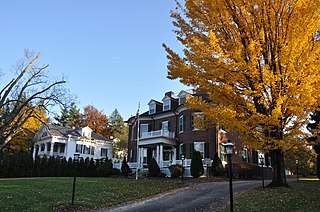
The Andover Street Historic District is a linear residential historic district in the Belvidere neighborhood of eastern Lowell, Massachusetts. The district encompasses large, fashionable houses and estates that were built between the 1860s and the 1930s. It includes properties at 245—834 Andover Street, and at 569 and 579 East Merrimack Street. The district was listed on the National Register of Historic Places in 2000.

The Brown–Maynard House is a historic house in Lowell, Massachusetts.
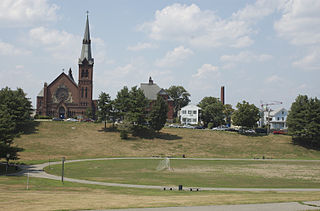
The South Common Historic District of Lowell, Massachusetts, encompasses the city's South Common and the various public, religious, and private residential buildings that flank its borders. The South Common, about 22.5 acres (9.1 ha) in size, was purchased by the city in 1845 in an auction by the Proprietors of Locks and Canals, who owned much of the city's industrial area. Although the common was landscaped, it was not apparently done so to a plan. It quickly became lined with fashionable residences, and several iconic public buildings, including the 1850 courthouse, a Romantic Revival structure designed by Ammi Young, and a series of Gothic Revival churches. Highland Avenue was built out with a series of fine Italianate houses.
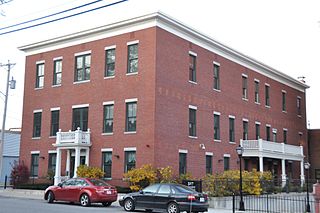
St. Joseph's Convent and School is a historic convent and school at 517 Moody Street in Lowell, Massachusetts. The school is a three-story brick building built in 1883. Its Italianate styling includes an extended wooden cornice decorated with brackets. The convent, built in 1911, is a modestly ornmanented Colonial Revival three-story brick building. Most of the interiors of the buildings were significantly altered over the course of the 20th century, losing most of their historical integrity; however, a 2001 rehabilitation has reintroduced interior styling in keeping with the age and style of the buildings.

The Varnum School is a historic former school building in Lowell, Massachusetts. The Greek Revival building was built in 1857, and was the first school built in the city's Centralville section after it was annexed to the city in 1851. The building was altered with a minor addition added in 1886, and a substantial Classical Revival addition was made in 1896. The building was listed on the National Register of Historic Places in 1995. Vacant since the 2000s, it is now owned by a developer, and is slated for conversion to housing units.

Mount Feake Cemetery is a historic cemetery at 203 Prospect Street in Waltham, Massachusetts.

The Central Square Historic District is a historic district encompassing much of the central business district of Stoneham, Massachusetts. It includes the town's largest concentration of 19th and early-20th century commercial architecture, in an area that developed in importance as a commercial center after the construction of the Andover-Medford Turnpike. The district was added to the National Register of Historic Places in 1990.
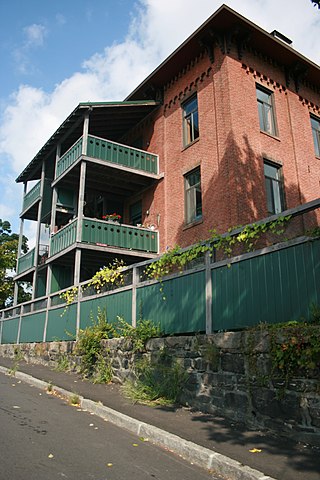
The Ash Street School is a historic school building at 4 Ash Street in Worcester, Massachusetts, United States. The Italianate style school was built as part of a wave of school construction in the city between 1848 and 1855, and is the city's second oldest surviving school. The building was listed on the National Register of Historic Places in 1980. It is presently home to a local land conservation organization.
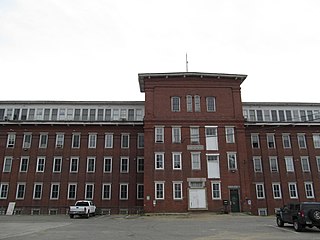
The Salmon Falls Mill Historic District encompasses a historic mill complex on Front Street in Rollinsford, New Hampshire. The complex includes four major structures and seven smaller ones, on about 14 acres (5.7 ha) of land along the Salmon Falls River. They were built between about 1840 and the mid-1860s, and have an unusual architectural unity, for additions made to the buildings were done with attention to matching design elements from the existing structures. The Number 2 Mill, built in 1848, was an early location where a turbine was used instead of a waterwheel to provide power to the mill machinery. The district was listed on the National Register of Historic Places in 1980.





















